“Circle the Food Wagons!” I gave that title to a Shaping San Francisco Talk we had last night at Counterpulse, featuring folks from local small farm/gardening projects and also John Garrone, who is the “mushroom guy” at the Heart of the City Farmers’ Market. It was one of those evenings that makes me happy and proud to be hosting this ongoing series of Talks. Smart, engaging speakers presented their histories, politics, and passions, followed by equally compelling questions and comments from the audience that extended and deepened the reach of the discussion. Much to my chagrin, we had a technical failure with our usual digital recording, so while we had a great evening, no one will be able to hear it via our online archive.
Instead, I’m going to try to summarize some of the highlights here. Leading the presentation were Brooke Budner and Caitlyn Galloway who are co-owners of Little City Gardens, a market-garden business in San Francisco. They described their year-long process of deciding that the gap they wanted to fill in the local food ecology was that of the small, self-sufficient producer, a small business that could survive on its own sweat and effort by selling the food it grows. They started on a 16th of an acre plot in a Mission district backyard growing artisanal salad greens, and with success in their first year, decided to seek a larger piece of land on which to expand their efforts. They used the Kickstarter website to launch a fundraising campaign that netted them $20K in small donation startup capital, found a landowner with a ¾ acre plot under the I-280 freeway in the southern part of the City, signed a one-year lease, and began clearing land. Before long they learned that the vague assurances they had gotten at the Dept. of Planning about their compliance with zoning regulations were unfounded. Now they’re trying to gain an exemption from the arduous process of getting a conditional use permit (which could take over a year and cost up to $8,000). They are also planning to seek permission to drill a well directly into the very high water table beneath the land, which is probably either fill or original riparian corridor along Islais Creek, still burbling along beneath the neighborhood on its way to the Bay. Little City Gardens is still taking donations and offers a quarterly magazine, hand-screen prints, and other goodies to their supporters, in addition to abundant fresh produce that they sell to local restaurants.
Through this experiment in urban market-gardening, they are interested in publicly asking the question: what does it take to run an economically viable urban farm business? And specific to San Francisco, what are the challenges, and what are the benefits?
Next up was the Free Farm, represented by Lauren Anderson and Case Garver, which is a new garden farm on an empty sand lot at Eddy and Gough where an old Lutheran Church burned down in 1995. After fifteen years of lying fallow and gathering garbage and debris, the collaborative effort of several non-profit organizations (including Lauren’s Produce to the People), community groups and individuals got permission from the Lutheran Church to begin an organic farm there. One of the stalwarts of this effort is Tree, who also runs the Free Farm Stand at 23rd and Treat every Sunday, just a block from Kaliflower where he has lived off and on. Kaliflower is the venerable commune dating back to the late 1960s that sits on a big corner lot along the old railroad right-of-way at 23rd between Folsom and Shotwell. Tree and Lauren’s group and others are also involved in an effort to more regularly glean local fruit trees and other food sources that are too often neglected around the city’s backyards and sidewalks.
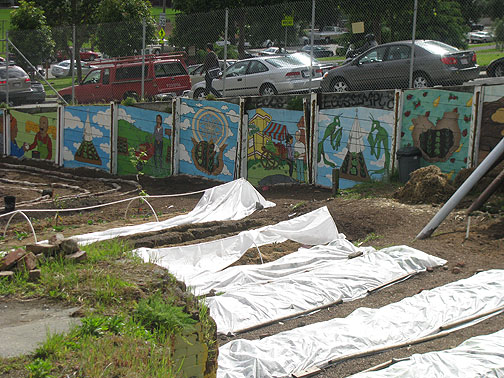
Covered beds a month ago along the Gough Street side of the Free Farm. They've since been opened and are flourishing.
Case spoke to the community-building aspects of the Free Farm, how they spend a lot of time focused on wellness and checking in with each other, consensing on how the garden is designed and how it will be worked, how its produce will be distributed to folks in the neighborhood, etc. His roots are in a Jesuit religious community, and a spiritual approach is a strong presence in the Free Farm, giving its commitment to free food an almost evangelical feeling. Nevertheless, the day-to-day experience of working together, bringing a food producing garden to life in what was just a long-neglected scrabbly sand lot is a powerful material experience, regardless of what overtones are added.
John Garrone is the current president of the Heart of the City Farmers’ Market where his Far West Fungi has long been a fixture. I’ve been shopping at that fantastically multicultural and multilingual market for twenty years, practically every Wednesday. John is a warm, lovely guy and it turns out he has deep roots in Bay Area agriculture. Though he didn’t imagine he’d become a farmer, his own family were farmers in the Santa Clara valley. He filled in some of the history of the Farmers’ Market going back to the Victory Gardens food surpluses of the WWII era, and told too about his own experience in starting a mushroom growing operation in a Hunters’ Point warehouse soon after the Navy had shut down the Naval shipyard. He later moved his growing operation to Watsonville and then to Moss Landing, though he lives in San Bruno, just south of the City.
He told how the City transferred responsibility for the Farmers’ Markets to the Dept. of Real Estate and how that led to a big fight over the future of the Heart of the City Market. It started in the early 1980s after an effort by the then-North of Market Planning Coalition and other Tenderloin-based groups to establish it, in order to provide fresh food to the inner city residents there who had no local stores with fresh produce. It’s been run for years by a nonprofit and when the City tried to take over, it sparked strong resistance by the farmers and the neighborhood, which fended it off for now.
Jay Rosenberg is the Volunteer Coordinator for the San Francisco Permaculture Guild, and is one of the organizers and volunteers at the Hayes Valley Farm, which happens to sit just a few blocks from the Free Farm. Where the Free Farm’s site is a block from the former onramp to the Central Freeway at Turk and Gough, the Hayes Valley Farm is a much larger block of land, a magical mystery smack dab in the middle of the former on and off ramps between Oak, Fell, Octavia, and Laguna streets.
The former freeway ramps are still present and the Hayes Valley farmers have been making good use of them” putting potted fruit trees on the former onramp in a simulated “natural traffic jam” (will it someday be producing real jam?); and using the slopes where cement freeways once went airborne as agricultural terraces, now heavy with flourishing fava bean plants.
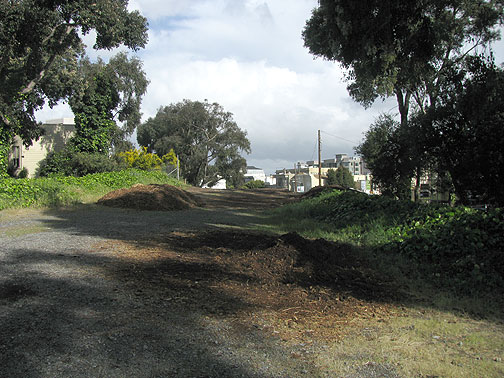
The former offramp has yet to be repurposed, but its supporting slope is now supporting a crop of fava beans!
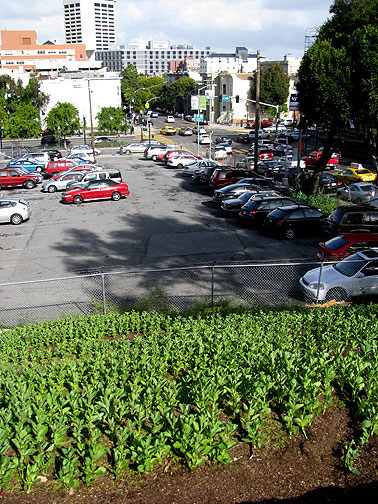
Buildings at Market and Van Ness can be seen in distance. Octavia Blvd. and Oak Street intersection is just past the parking lot in the foreground.
Like the Free Farm, Hayes Valley is also committed to a community-building process, and happily, they seem to have hit the sweet spot with a new generation of aspiring urban agriculturists. Over 1,000 people have already spent time volunteering at the Hayes Valley Farm since their recent beginning at the end of January of this year! Given the history of this land as an anchorage to one of the most heavily trafficked corridors in the City, there has been some real concern about the health of the soil, but Jay told us they had conducted extensive testing and only found one small area that was too contaminated to grow food in. Still, they’ve done some incredible work, having had several tons of cardboard donated by Google (and trucked up the peninsula at their expense) which they are using under several tons of organic mulch as a weed cover. It will biodegrade into the area after some months, and meanwhile, the volunteers are getting a crash course in building soil, turning the old freeways into an inspiring experiment in urban agriculture.
One of the recurring factors facing all the San Francisco farming projects was the temporary nature of their access to the land. From the one-year lease signed by Little City Gardens, to the 2-3 year agreements that both Free Farm and Hayes Valley Farm have made with their respective landowners, a lot of effort is going in to land that may be built in within a few short years. Some in the audience wondered about that, but a common feeling was that this is the time to show what’s possible, and even in temporary farm gardens you can do a lot. The Free Farm has already harvested 80 lbs. of produce in the short time since they planted, for example. No one had any illusions that these efforts alone could achieve urban food self-sufficiency, but at the same time, such a goal is truly impossible without the skills, knowledge, and practical experiences people are gaining in these projects. What’s more, the lasting legacy of these efforts, however long or briefly they last, is the powerful impact on people’s imaginations. They show how radically different it COULD be, and if we persist, WILL be!

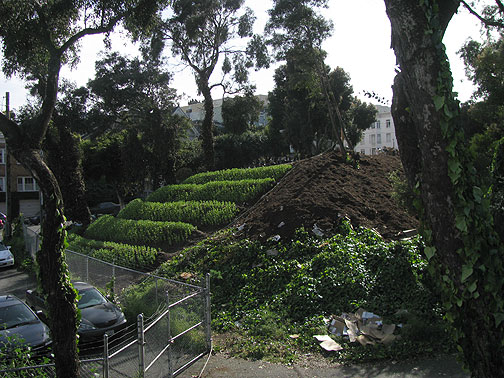
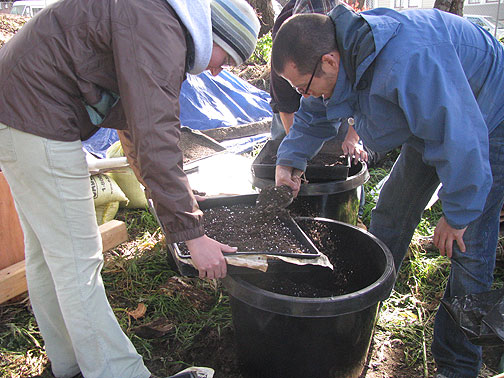


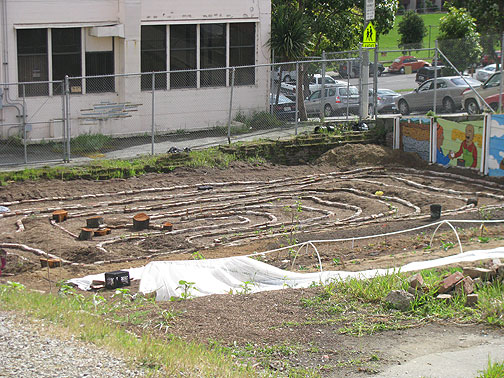
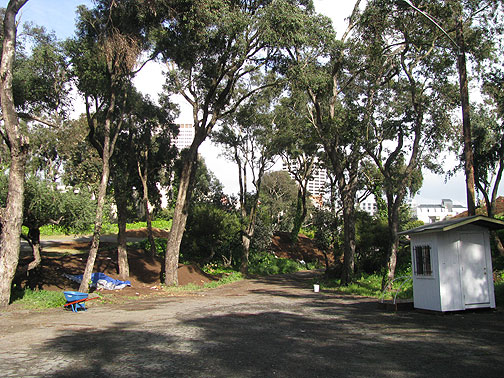
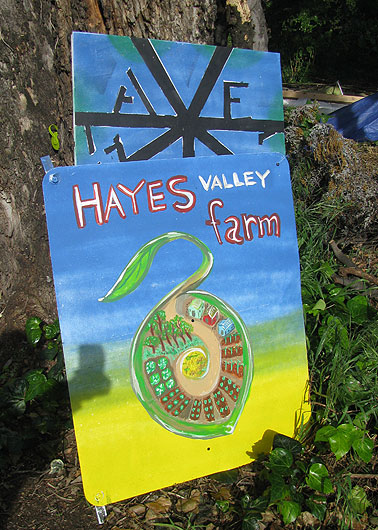
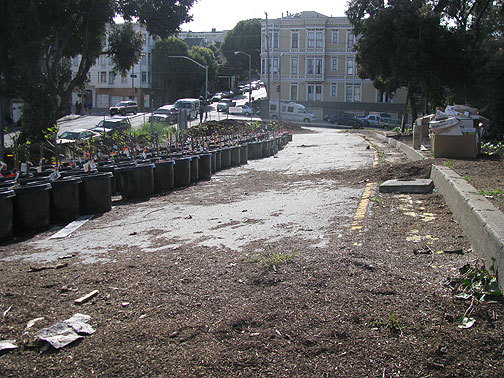
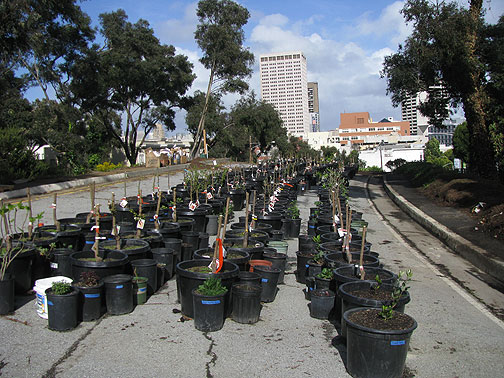











It’s a mammoth playground built of mountains, hills, lakes, dkbddfkedddd